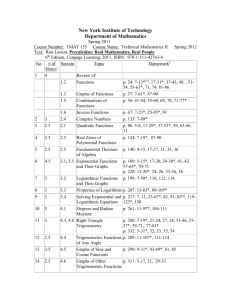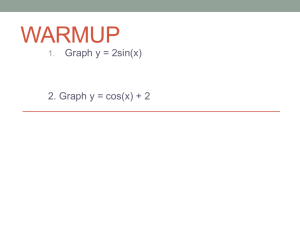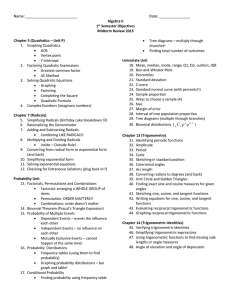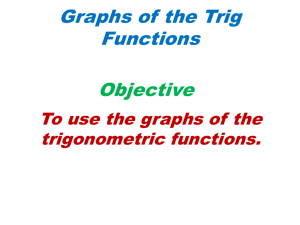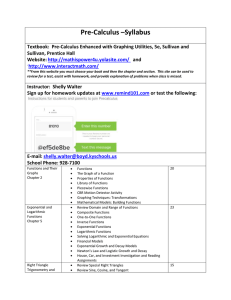Facilitator's Guide: Module Focus Algebra II Module 2
advertisement
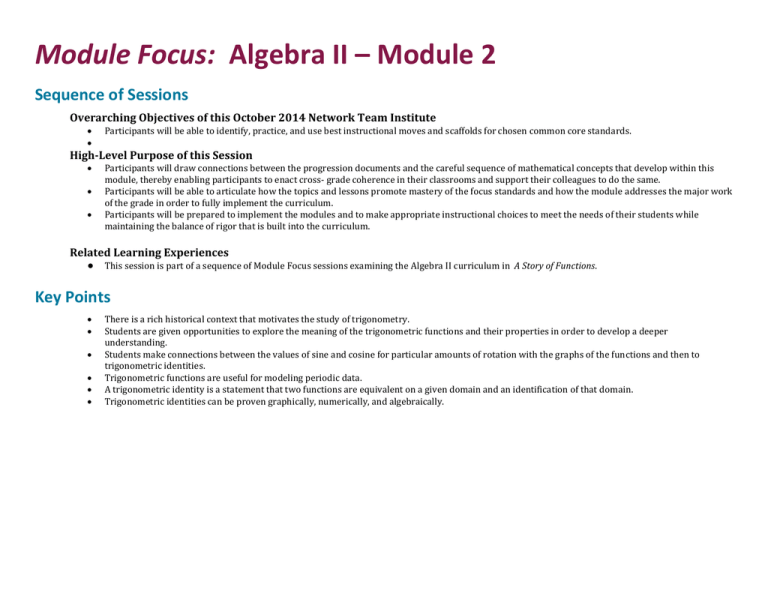
Module Focus: Algebra II – Module 2 Sequence of Sessions Overarching Objectives of this October 2014 Network Team Institute Participants will be able to identify, practice, and use best instructional moves and scaffolds for chosen common core standards. High-Level Purpose of this Session Participants will draw connections between the progression documents and the careful sequence of mathematical concepts that develop within this module, thereby enabling participants to enact cross- grade coherence in their classrooms and support their colleagues to do the same. Participants will be able to articulate how the topics and lessons promote mastery of the focus standards and how the module addresses the major work of the grade in order to fully implement the curriculum. Participants will be prepared to implement the modules and to make appropriate instructional choices to meet the needs of their students while maintaining the balance of rigor that is built into the curriculum. Related Learning Experiences ● This session is part of a sequence of Module Focus sessions examining the Algebra II curriculum in A Story of Functions. Key Points There is a rich historical context that motivates the study of trigonometry. Students are given opportunities to explore the meaning of the trigonometric functions and their properties in order to develop a deeper understanding. Students make connections between the values of sine and cosine for particular amounts of rotation with the graphs of the functions and then to trigonometric identities. Trigonometric functions are useful for modeling periodic data. A trigonometric identity is a statement that two functions are equivalent on a given domain and an identification of that domain. Trigonometric identities can be proven graphically, numerically, and algebraically. Session Outcomes What do we want participants to be able to do as a result of this session? Participants will draw connections between the progression documents and the careful sequence of mathematical concepts that develop within this module, thereby enabling participants to enact cross- grade coherence in their classrooms and support their colleagues to do the same. Participants will be able to articulate how the topics and lessons promote mastery of the focus standards and how the module addresses the major work of the grade in order to fully implement the curriculum. Participants will be prepared to implement the modules and to make appropriate instructional choices to meet the needs of their students while maintaining the balance of rigor that is built into the curriculum. How will we know that they are able to do this? Participants will be able to articulate the key points listed above. Session Overview Section Time Overview Introduction 33 min Introduces Grade 11 Module 2 Algebra II Module 2 PPT Facilitator Guide 175 min Explore how trigonometric functions are defined as functions and the graphs of the sine and cosine function are used to discover basic trigonometric identities. Algebra II Module 2 PPT Facilitator Guide Mid-Module Assessment 35 min Allows Participants to complete a Mid-Module Assessment and follow up discussion. Algebra II Module 2 PPT Facilitator Guide Review Mid-Module Assessment Topic B: Understanding 133 min Explore how trigonometric functions can model periodic Algebra II Module 2 PPT Facilitator Guide Review Topic B Topic A: The Story of Trigonometry and its Contexts Prepared Resources Facilitator Preparation Review Grade 11 Module 2 Review Topic A Trigonometric Functions and Putting Them to Use End of Module Assessment behavior and the concept of polynomial identities. 44 min Allows Participants to complete an End of Module Assessment and follow up discussion. Algebra II Module 2 PPT Facilitator Guide Review End of Module Assessment Session Roadmap Section: Introduction Time: 33 minutes In this section, you will be introduced to Grade 11 Module 2. Materials used include: “Grade 11 Module 2” PPT “Grade 11 Module 2” Facilitators Guide Time Slide # Slide #/ Pic of Slide Script/ Activity directions 3 min Introduce ourselves and talk about the session. 1. Mostly we will be working on the student pages located at the front of your binder. Avoid looking at the teacher pages for the most part. I mainly want you to experience the module from the student perspective. GROUP 5 min 2. Start here. Then back up to opening slide. Give participants 5 min to do the opening exercise. After intro, come back to the opening exercise and share graphs. Why is trigonometry based on movement around a circle? Why not a square? 3 min 3. In order for us to better address your individual needs, it is helpful to know a little bit about you collectively. Pick one of these categories that you most identify with. As we go through these, feel free to look around the room and identify other folks in your same role that you may want to exchange ideas with over lunch or at breaks. By a show of hands who in the room is a classroom teacher? Math trainer? Principal or school-level leader District-level leader? And who among you feel like none of these categories really fit for you. (Perhaps ask a few of these folks what their role is). Regardless of your role, what you all have in common is the need to understand this curriculum well enough to make good decisions about implementing it. A good part of that will happen through experiencing pieces of this curriculum and then hearing the commentary that comes from the classroom teachers and others in the group. 2 min 4. We have three main objectives for this morning’s work. Our main task will be experiencing lessons and assessments. As a secondary objective, you should walk away from the study of Module 2 being able to articulate how these lessons promote mastery of the standards and how they address the major work of the grade. Lastly, you should be able to get a sense for the coherent connections to the content of earlier grade levels. 2 min 5. Here is our agenda for the day. We will spend most of our time on G11 M2. As we go through the module, I will talk about foundational skills developed in prior grades. We will discuss some fluency drills and other scaffolds that can be used to address possible gaps in content knowledge. We will also discuss how this develops skills needed for grade 12 (precalculus). 3 min 6. (Go through the bullets to give an overview of the progression or flow of each topic and the module as a whole.) 5 min 7. Display and have participants read the Module overview, scan the standards and the new terminology. This slide needs work….mention that the approach is exploration (very few problem set lessons), talk about the definition of theta as a rotation. -------------I’m going to try paraphrasing from the module overview, noting the key points. I’m not sure how to get the theta as rotation point across without speaking in negatives – which I want to avoid. Can we emphasize this later on? Yes, I think we mention it here and continue to emphasize throughout. 8 min 8. (Review the bullet points with participants to remind them of the background students are coming in to this module with.) We will be discussing in more detail as we go through the module what students’ previous experiences have been 2 min 9. Section: Topic A: The Story of Trigonometry and its Contexts Time: 175 minutes In this section, you will explore how trigonometric functions are defined as functions and the graphs of the sine and cosine function are used to discover basic trigonometric identities. Materials used include: “Grade 11 Module 2” PPT “Grade 11 Module 2” Facilitators Guide Time Slide Slide #/ Pic of Slide # Script/ Activity directions 5 min Read the topic A opener. 10. Note that all the lessons are either exploratory or socratic. 8 min 11. Supplies: Rulers, protractors, graph paper, card stock or manila folders, metal brad/fastener. Give participants time to work L1 Exploratory challenge 1. Share some graphs. Model the classroom discussion. What sort of graphs would you expect to see from students? Note varying levels of precision on the graphs. Give participants time to work L1 Exploratory challenge 2 and the exploratory challenge in L2. Discuss and share results. Students come away with a context about how circular motion can be described using both a vertical and horizontal component and the fact that this motion leads to a new type of function that we have not seen GROUP before. The ferris wheel will be referred to periodically throughout the module as a familiar reference when thinking about circular motion. We will explore how to create a function to model the motion of the ferris wheel later in the module. 8 min 12. Using this definition, why is the Ferris wheel height function an example of a periodic function? Is the co-height also a periodic function? Why was it logical to call it the co-height? 10 min 13. Provides historical context to tracking circular motion. What would astronomers have been interested in? • Pinpointing the location – distance from earth, rotation from the horizontal • height and “overness” • Quadrants helped to track a location (think about how they are numbered) Why is counterclockwise considered positive? Why do clocks rotate in the opposite direction? Think back to opening exercise. If stars “moved” in a square motion, we would have squine and cosquine instead. Finally, at the end of this lesson, the term “sine” is mentioned. 10 min 14. Supplies: protractor, paper, colored pencils Give participants time to work example 1 and 2. Discuss. Look at problem set problems. Give them instructions on the graphic organizer and let them offer suggestions or ideas. To build fluency, sprints could be used throughout this module. 5 min 15. Supplies: protractor, paper, colored pencils Make sure students realize they don’t have to memorize the quadrants in which sine and cosine are positive and negative if they understand how the sine and cosine functions are defined. Students could add to their graphic organizer throughout the module. 5 min 16. 17. 10 min 18. We already extended the domain from (0,90) to (0,360). After this lesson we will have examined all possible rotations and therefore extended the domain to include all real numbers. 15 min 19. Allow time to work opening exercise. It seems strange that we learned about lines tangent to circles and this trigonometric function called tangent. Coincidence? Or is there a connection between the two? Work on exercises 2 – 6 (on doc cam or give participants time). 5 min 20. Before revealing, ask participants to share ways in which tangent is interpreted in this lesson. 20 min 21. Without the geometric context, secant, cosecant, and cotangent make little sense to the students. The second question is one my students always ask…if the names are just random why not pair cosine with cosecant? We really only need sine and cosine functions. The rest of trig can be worked with these two. sec𝜃 could just as easily be written 1/cos𝜃. It was settled upon for the purpose of printing. sec𝜃 was much easier to produce on a printing press than 1/cos𝜃. Work through opening exercise, example 1, and exercise 1. Discuss. If ahead of schedule, work through more of the lesson. 25 min 22. Supplies: sprints A and B A sprint is another fluency exercise that can help to bridge gaps in knowledge and increase automaticity of a skill. They are fast-paced and don’t take up too much class time. Students worked with radicals to some extent in G9 and G10. They also covered them in Lesson 9 of this module. But this is still an area where there could be potential gaps in content knowledge. This might be a good place to do a rapid white board exchange as we saw earlier or a sprint. We are going to do a sprint now. Conduct sprint. 5 min 23. Note that we are still working exclusively in degrees at this point. We use the rotations that are multiples of 30, 45, 60 or 90 degrees. Make a point that we have learned enough values of sine and cosine to enable us to construct their graphs. The first 5 key features are the same ways in which we described polynomial graphs. Now we have periodic functions. We need ways to describe the repetition of the graphs. Note that these two terms (amplitude and period) are only being INTRODUCED in this lesson. Mastery of the definitions or meaning is not expected at this point. 5 min 24. Students have worked with degrees for many years. They are comfortable with degrees and probably see no reason to switch. The graph might not be compelling to students. After all, we know that we can rescale the horizontal axis. There is no reason we must use a square grid. This is not the real reason that we are switching from degrees to radians. 5 min 25. Supply: graphing calculator If participants have graphing calculators, ask them to find the limit first with the calculator in degrees and then in radians. If they do not have g.c., demonstrate using demos. 10 min 26. Work exit ticket. Then, talk through the lesson summary. Point out the approach taken in the lesson on converting between degrees and radians (not relying on formulas but rather thinking of fractions of a turn) 5 min 27. If ahead of schedule, look at problem set # 6 – 10 5 min 28. 10 min 29. Discuss the identities. Complete problem set #3, 4, 7, 8. 2 min 30. 5 min. Total time elapsed: 200 minutes + 20 minutes discussion/questions/break = 220 minutes or 3 hours and 40 m (Go through each point listed.) Opening the module with circle-ometry and leading into trigonometry makes the content more relatable to students. Students often come away from trig with no concept of what it actually is (i.e. thinking it is ok to write sin = 1 or that sinx/x = sin or that xsinx = sin(x^2)) 2 min 31. Section: Mid-Module Assessment Time: 35 min In this section, you will allow Participants to complete a MidModule Assessment and follow up discussion. Materials used include: “Grade 11 Module 2” PPT “Grade 11 Module 2” Facilitators Guide Time Slide # Slide #/ Pic of Slide Script/ Activity directions 25 min 32. Have participants locate the assessment. Give them approximately 25 min to take the assessment with their partner. After 20 minutes have passed give a verbal warning for them to scan any remaining questions that they have not yet attempted. If everyone finishes early, stop this part and start the next portion of this session. 8 min 33. Again, work with a partner to examine your work against the rubric and exemplar. If you have any questions or concerns, jot them down on a post-it note and we will address those before we move on. After 10 minutes or so have passed, call the group together and address any questions or concerns that participants noted on their post-it notes. GROUP 2 min 34. Section: Topic B: Understanding Trigonometric Functions Time: 133 min and Putting Them to Use In this section, you will explore how trigonometric functions can model periodic behavior and the concept of polynomial identities. Materials used include: “Grade 11 Module 2” PPT “Grade 11 Module 2” Facilitators Guide Time Slide Slide #/ Pic of Slide # Script/ Activity directions 5 min Read topic opener for topic B 35. GROUP 5 min 36. Keep in mind that students studied these transformations extensively in 9th grade. Where they may run into trouble is working with the scaling on the horizontal axis. 15 min 37. Why would the frequency be an important characteristic? Frequency is not “part of the wave” like the amplitude, period, etc. In Physics it refers to the number of waves per some time interval (often cycles per second or Hertz). When the period is decreased, the frequency increases (more waves per interval) Work exercise c and d. For (c), discuss the effect of the negative. Could we rewrite the function using an identity from topic A ? [sin(-x) = sinx] If ahead of schedule, work problem set extension problems # 4 and 5. 20 min 38. Supply: graphing calculator Give participants time to work through exercises 1 – 5 (exploratory challenge) Discuss the questions from the slide. If ahead of schedule, work the exit ticket. 25 min 39. Supply: graphing calculator Students look at a variety of periodic phenomena and model the data both with and without technology. This graph shows the tides at Montauk, NY for the week of May 21–28. Discuss this graph as a group. What is the period? Why does it mean in terms of the tides? What is the phase shift? Is that the only possible phase shift? Could we write the function as a cosine function? Sure, but generally sine is used to model data. Note that the graphing calculator only has sine regression. Write the equation. Note that students are most likely to make a mistake with “w.” Have them work through Exercises 2 – 6. Have the data saved on the graphing calculator and transfer to their calculators to demonstrate how this might save time in class. Discuss the activity. 15 min 40. Go through each point. In exploring the graph, students realize that tangent is also periodic. What is the period of the tangent function? Work on Exploratory challenge 2 (exercises 6 – 16). Discuss. 5 min 41. Click to advance. Where do these 3 identities come from? The period of each function Click to advance. Where do these 3 identities come from? Sine is an odd function, cosine is even, tan(-𝜃)=sin(-𝜃)/cos(-𝜃) Click to advance. 10 min 42. Supply: graphing calculator Go through each point. Look at exercise 3. One way to prove or determine whether an equation is an identity is to graph each side. Demonstrate with the g. calc. or with Desmos. 10 min 43. Squaring both sides is not guaranteed to preserve equality. It is an irreversible step that potentially alters a solution set. Work through example 1 and if ahead of schedule problem set 2. Students should never try to establish an identity by starting with that identity. That is the mathematical equivalent of the statement “If I am the Queen of England, then I am the Queen of England.” That statement does not actually mean that I am the Queen of England. 15 min 44. Students spend the first part of grade 12 module 1 looking at the topic of linearity. They spend the first few lessons exploring the notion of “Does linearity hold?” Unfortunately it does not and we realize that sin(x+y) sin(x) + sin(y). Work examples and discuss. Then work problem set #1 if time permits. 2 min 45. 5 min. Total time elapsed: 395 minutes +15 minutes discussion/questions/break = 410 minutes or 6 hours and 50 m (Go through each point listed.) 4 min 46. Leave this slide blank. Ask participants to list key points or ideas from module 1. Ex. Take a moment now to re-read the standards that this module covers… Can you think back to moments in the lessons that get students to arrive at those understandings? What things stand out to you now that did not stand out early on? 2 min 47. Section: End of Module Assessment Time: 44 min In this section, you will allow Participants to complete an End of Module Assessment and follow up discussion. Materials used include: “Grade 11 Module 2” PPT “Grade 11 Module 2” Facilitators Guide Time Slide # Slide #/ Pic of Slide Script/ Activity directions 25 min Have participants locate the assessment. Give them approximately 25 min to take the assessment with their partner. After 20 minutes have passed give a verbal warning for them to scan any remaining questions that they have not yet attempted. If everyone finishes early, stop this part and start the next portion of this session. 48. GROUP 8 min 49. Again, work with a partner to examine your work against the rubric and exemplar. If you have any questions or concerns, jot them down on a post-it note and we will address those before we move on. After 10 minutes or so have passed, call the group together and address any questions or concerns that participants noted on their post-it notes. 6 min 50. (Review each key point one at a time.) 5 min 51. 10 min Total time elapsed: 475 minutes or 7 hours and 55 m Take a few minutes to reflect on this session. You can jot your thoughts on your copy of the powerpoint. What are your biggest takeaways? (pause while participants reflect then click to advance to the next question). Now, consider specifically how you can support successful implementation of these materials at your schools given your role as a teacher, school leader, administrator or other representative. Use the following icons in the script to indicate different learning modes. Video Reflect on a prompt Turnkey Materials Provided ● Algebra II Module 2 PPT ● Algebra II Module 2 Facilitator’s Guide Additional Suggested Resources ● ● ● How to Implement A Story of Functions A Story of Functions Year Long Curriculum Overview A Story of Functions CCLS Checklist Active learning Turn and talk
